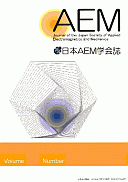31 巻, 4 号
選択された号の論文の8件中1~8を表示しています
- |<
- <
- 1
- >
- >|
特集 生体モニタリング技術
-
2023 年31 巻4 号 p. 497-
発行日: 2023年
公開日: 2024/01/24
PDF形式でダウンロード (647K) -
2023 年31 巻4 号 p. 498-503
発行日: 2023年
公開日: 2024/01/24
PDF形式でダウンロード (1501K) -
2023 年31 巻4 号 p. 504-509
発行日: 2023年
公開日: 2024/01/24
PDF形式でダウンロード (2643K) -
2023 年31 巻4 号 p. 510-516
発行日: 2023年
公開日: 2024/01/24
PDF形式でダウンロード (2032K) -
2023 年31 巻4 号 p. 517-524
発行日: 2023年
公開日: 2024/01/24
PDF形式でダウンロード (2367K) -
2023 年31 巻4 号 p. 525-530
発行日: 2023年
公開日: 2024/01/24
PDF形式でダウンロード (1678K)
一般論文[学術論文]
-
2023 年31 巻4 号 p. 531-541
発行日: 2023年
公開日: 2024/01/24
PDF形式でダウンロード (3132K)
書評
-
2023 年31 巻4 号 p. 542-
発行日: 2023年
公開日: 2024/01/24
PDF形式でダウンロード (653K)
- |<
- <
- 1
- >
- >|
